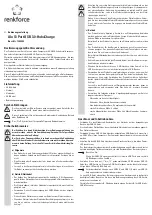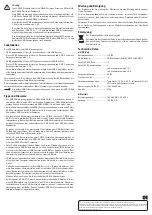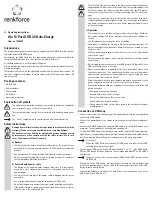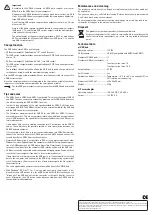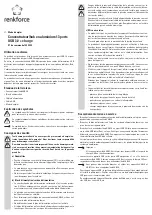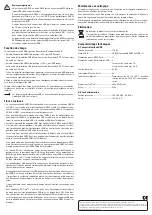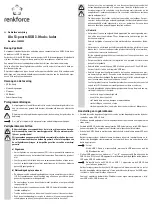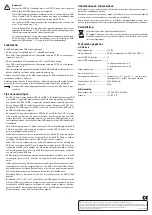
This is a publication by Conrad Electronic SE, Klaus-Conrad-Str. 1, D-92240 Hirschau (www.conrad.com).
All rights including translation reserved. Reproduction by any method, e.g. photocopy, microfilming, or the capture in electronic data
processing systems require the prior written approval by the editor. Reprinting, also in part, is prohibited. This publication represent
the technical status at the time of printing.
© Copyright 2015 by Conrad Electronic SE.
Important!
According to the USB3.0 standard, a USB3.0 ports supplies a current of
900 mA (e.g. the USB3.0 port of your computer).
However, many USB3.0 devices only require a much lower current, e.g. USB
sticks. Other USB3.0 devices are powered by their own power adapter (e.g.
large USB3.0 hard drives).
One of the two USB outputs can provide an output current of max. 1 A, the
other max. 2.4 A.
Note that the power adapter provided therefore cannot supply all outputs
(USB ports 1 - 13 and the two USB current outputs) with the maximum pos-
sible current at the same time.
The output power of the power adapter provided is 60 W, of which about
59 W are provided for all connected USB devices (USB ports 1 - 13 and the
two USB current outputs).
Charge function
The USB hub has two USB current outputs:
• USB current output #1 (labelled with “1A”, red USB socket)
This USB current output provides an output voltage of 5 V/DC and an output current
of max. 1 A.
• USB current output #2 (labelled with “2.4A”, red USB socket)
This USB current output provides an output voltage of 5 V/DC and an output current
of max. 2.4 A.
The intelligent device detection allows the USB hub to quick-charge almost all
smart phones or tablets with the maximum charging current.
Use the USB charging cable provided with your smart phone or tablet to connect it to
a USB current output.
Since the charging electronics are integrated in the smart phone or tablet, the charg-
ing process is controlled and completed by the smart phone or tablet.
The two USB power outputs are only active when the USB3.0 hub is switched
on.
Tips and notes
• The USB3.0 hub is USB2.0 and USB1.1 compatible. This means that normal USB2.0
and USB1.1 devices can be used without any problems on the USB3.0 hub. However,
this will not speed up the USB2.0/ USB1.1 devices.
• In order to take advantage of the high speed provided by USB3.0, all the devices
must support USB3.0: The USB device itself (e.g. an external hard disk), the USB hub
and the USB controller in the computer.
• The theoretical maximum speed for USB3.0 (or also USB2.0 or USB1.1) is never
achieved in practice. This is due to protocol information, simultaneous operation of
several USB devices or the speed limit of the connected device or the USB control-
lers/ motherboards.
It also makes little sense to simultaneously operate 13 hard drives via the USB3.0
hub, as those will share the possible volume of data transmission between the
USB3.0 hub and computer.
If, for example, a lot of data is to be transferred between two USB3.0 hard drives,
connect the first hard drive to the USB3.0 port on the USB3.0 hub and connect the
second directly to a USB3.0 port on the computer.
• Normally USB operation is not possible in DOS or in the protected mode of older
Windows versions. Depending on the computer or the BIOS/Setup, however, opera-
tion of a USB keyboard and a USB mouse is possible. Nevertheless, it is necessary
to connect them directly to the computer’s USB interface and not to the USB hub.
• USB devices can be connected and disconnected during operation. You do not have
to switch off your computer if you want to insert or remove devices.
If data transfers are in progress on the USB port, e.g., if an external disk is writing
data to the computer, and you unplug the USB plug, the operating system might
crash. Furthermore, this may result in loss of data or damage to the file system of
the external drive.
The same applies when you press the switch on/off button of the USB3.0 hub.
• With Windows
®
XP, Vista™, 7 or 8, an icon with an arrow in the menu bar is dis-
played for some USB devices (e.g. for a USB hard disk). With this function you can
“disconnect” the USB device from the computer so that data transfer ceases to
occur. Afterwards, the USB device can be disconnected from the USB3.0 hub (or
the computer) without problems.
Maintenance and cleaning
The product is maintenance-free. Repair or maintenance work must be carried out
by a specialist.
You can use a clean, dry, soft cloth for cleaning. Dust can be very easily removed with
a soft, clean brush and a vacuum cleaner.
Do not use aggressive, chemical or scouring cleaning agents, as this may lead to dis-
colouration or changes in the material on the surface.
Disposal
The product must not be disposed of in the household waste.
Dispose of the product at the end of its serviceable life in accordance with
the current statutory requirements; e.g. return it to any suitable collection
point.
Technical data
a) USB hub
Operating voltage............................... 12 V/DC
USB standard...................................... USB3.0 (compatible with USB2.0 and USB1.1)
Number of USB3.0 ports ................... 13
Number of USB current outputs ...... 2
...............................................................
1x output current max. 1 A
...............................................................
1x output current max. 2.4 A
Output voltage .................................... 5 V/DC
On/Off switch ...................................... yes
Ambient conditions ............................ Temperature -10 °C to +60 °C, air humidity 10% to
85% relative, not condensing
Dimensions (L x W x H) ..................... 280 x 50 x 50 mm
Weight .................................................. 470 g
b) Power adapter
Operating voltage............................... 100 - 240 V/AC, 50 - 60 Hz
Output................................................... 12 V/DC, 5 A

